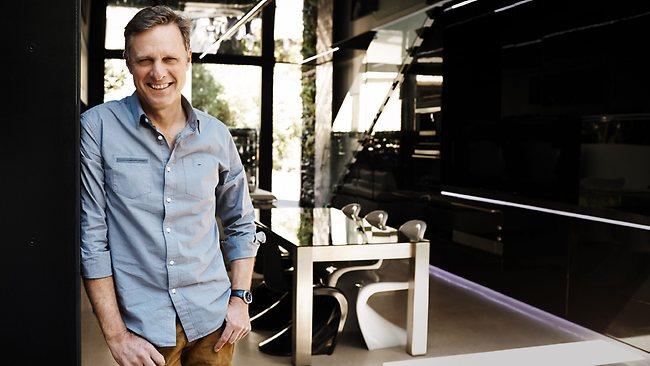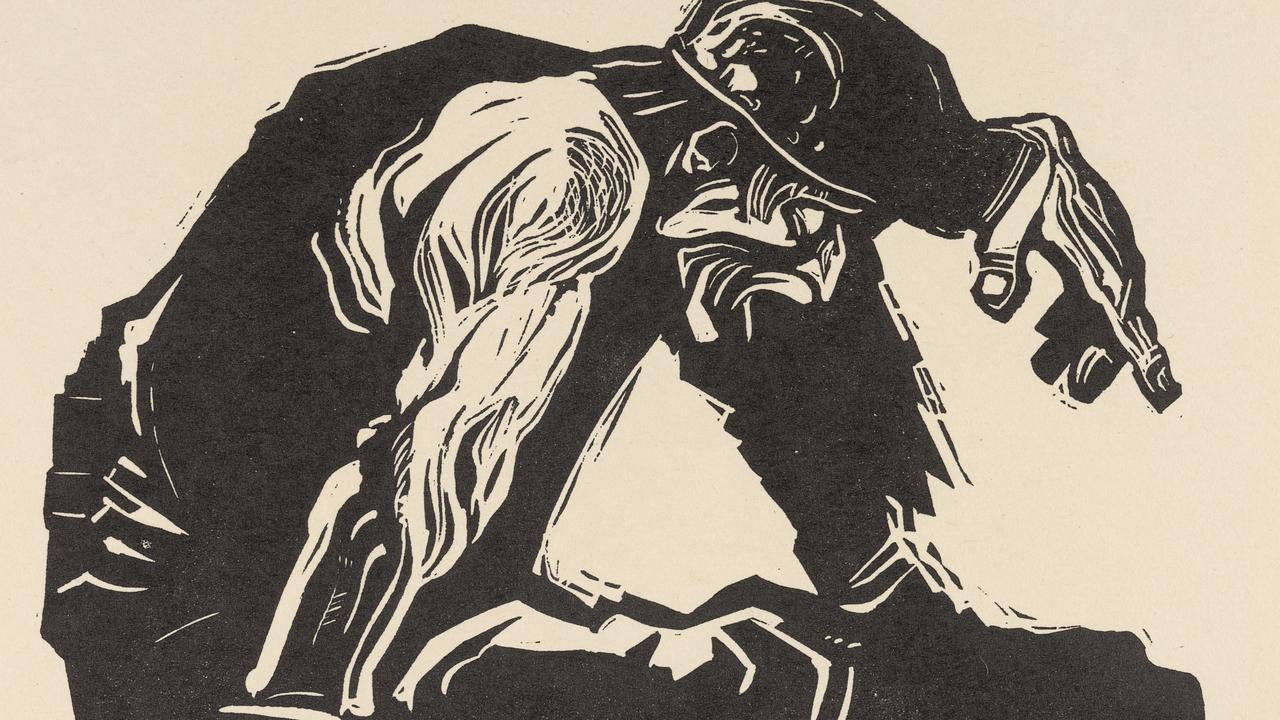Home truths revealed by architect Peter Maddison in Grand Designs Australia
THE latest series of Grand Designs Australia asks how much people are willing to sacrifice on the altar of architecture.

'IT is in dialogue with pain that many beautiful things acquire their value," popular philosopher Alain de Botton wrote in The Architecture of Happiness. He might have been talking about the classy reality TV show Grand Designs, the Australian version in particular, presented by architect Peter Maddison.
Maddison's local incarnation has begun to eclipse Kevin McCloud's original, which has been around since April 1999: 141 episodes across 12 series featuring unusual, often elaborate and sometimes heartbreaking architectural homebuilding projects.
"Acquaintance with grief turns out to be one of the more unusual prerequisites of architectural appreciation," de Botton continued, adding: "We might, quite aside from all other requirements, need to be a little sad before buildings can properly touch us."
And many of the houses McCloud has presented through the years - most of them exemplars of that once so popular spacious cuboid structure, with entire walls of glass and acres of polished concrete floors - have, it seems, become unhappy affairs. He said recently that when he returns to completed projects, among his Grand Designers' greatest laments is the sad fact that they went overboard on all that space and glass, that their homes became too big and problematical.
Curtaining the glass presented problems when the occupants tired of all the light streaming in, roasting them in British summers and freezing them in winter. McCloud tries to tell them, but one of the biggest rules of this kind of TV is that the expert is ignored as the owner-builders embark on their dreams, part therapy and largely fantasy.
"People in Grand Designs are on an incredible journey," McCloud says. "It is as if they have been captured by some cult. Their eyes glaze over."
These are people on a mission. David Lowe's distinctive title music is so aspirational it has become popular for wedding couples, in Britain and here too, to walk down the aisle to its soaring strings and that plaintive harp.
Maddison's local version, which returns this week for its fourth season, also investigates the possibility of personal redemption though self-improvement, and there's always a lot of grief and angst as property dreams are so passionately pursued across Australia.
Both shows are highly inventive twists on reality TV's voracious appetite for voyeurism, blending the lifestyle demonstration convention with the cultural anthropology of cinema verite and the travel narrative.
Maddison's show - the LifeStyle channel's most successful local production - charts the progress of some very elaborate design projects. This year they're turning green, with the featured owners moving towards more eco-friendly builds.
In a nice twist, this season features homeowners who have thrown in their day jobs to follow their dreams. Each time, you wonder how these people can turn the initial details of such complex blueprints into practical living spaces. As Frank Lloyd Wright said, "A doctor can bury his mistakes, but an architect can only advise his clients to plant vines."
The other strong theme, the amiable Maddison says, is the use of locally sourced materials with low carbon miles: "Humble materials like rammed earth, wool, volcanic rock, straw, felled timber, handmade bricks and recycled sandstone form a pleasing trend, showing owners acknowledging the savings to the environment by keeping transportation to a minimum."
The first design he follows is for a spaceship-like dwelling at Inverloch, a seaside village in Victoria where the winds and rains sweep in from the Antarctic. The unconventional, challenging house from architect James Stockwell is for engineer Glenn Morris and his wife Kate, who call it a "windswept sand dune".
The plans call for massive curved beams, sculptural complexity and mind-bogglingly complex geometry. The sand dune is formed as the structure lies at right angles to the prevailing winds with a steep, concave leeward side and crescent tips pointing downwind.
There are many environmental features including a solar power system, in-slab heating powered by heat pump, rainwater harvested off the roof, and double-glazed windows.
Maddison loves the design but during the build worries whether logic, determination, precise planning and ingenuity will be a match for Victoria's weather.
Like McCloud, Maddison understands that houses are the material backdrop to the narrative of our lives. But there's less melodrama, more practical details and Maddison adds his clever, sometimes highly amused, architect's appreciation of each site.
He always gives you the sense that the reality side of his show with its schadenfreude and voyeurism is less interesting to him than ideas that celebrate architecture itself and good design.
While he and director Cesar Salmeron are quick to focus on the disagreements between couples - in this case Kate wants a house for humans and Glenn is far more interested in the abstracts of volume, height and natural materials - Maddison is more concerned to find time to tell us how his projects will shift the canon a bit. He's evangelical without ever being boring, a man of enormous natural charm who has his own grand plan to encourage creativity and ban mediocrity.
At the conclusion to this episode he says he likes architecture that is proud of the way it has been built, "where every single junction of materials displays the same honest simplicity and the same sublime craftsmanship. So much that it requires little or no decoration." Just like his show in some ways.
WE are emerging, in sensational fashion, from a period where natural history filmmakers stressed a scientific, dispassionate approach to nature, turning a seldom-interfering analytic eye to their subjects at the expense of storytelling.
Once they went to remote places and filmed everything that moved with their cumbersome equipment before returning to their editing suites where they spent years cutting it together. Then they presented the result as a film. Bringing natural history narratives alive to new audiences was hardly the point, even though the imagery was breathtaking and the science accurate.
"No people" natural history, it was called.
Now the audience has shorter attention spans and we want stories told with high excitement. Wildlife TV has to do battle with soaps, reality TV and the new cinematic-style HBO-style drama series. Audiences have become sophisticated in their understanding of plotlines and narrative development and the impetus now in wildlife TV is for stories that feature interesting, often eccentric and driven personalities who interact with animals in some way in exotic places.
It's a monumental change driven by the American factual channels, which have had huge success with long-running shows focused on groups of colourful characters, such as Deadliest Catch. Produced by the seemingly indefatigable Thom Beers, it is the most famous documentary-style reality series filmed and Discovery Channel's highest rating series. The same scarred boats turn up weekly, their ratbag crews like turbulent characters in an episodic seafaring novel. If you have never seen it, the series follows the now legendary captains and crews of six crab-fishing vessels doing one of the most perilous, and lucrative, jobs in the world: fishing for king and opilio crab in frigid Alaskan waters.
Almost as dangerous is the work done by the heavily armed rangers who patrol the flood plains and ancient sculptured escarpments of Kakadu, Australia's largest terrestrial park, danger and beauty often connoting the same thing to their wary eyes.
Filmed across 12 intense months, the ABC's new four-part series Kakadu, from Northern Pictures and Beach House Pictures, takes us behind the scenes as the rangers monitor biodiversity, battle raging bushfires, hunt massive rogue crocs that target fishing boats, and stake out the rogue hunters of the human kind. The latter are knockabout, piratical poachers raiding protected fish stocks and taking thousands of barramundi and crabs from within Kakadu's protective borders.
The rangers' beat is the size of Slovenia, about one-third the size of Tasmania, or nearly half the size of Switzerland. The mountains are as old as the convulsions of the Earth, some of the ranges coiled like prehistoric monsters; the landscape is often alluring beyond reason, voluptuous even, but always deadly.
As our rangers warn constantly, it is not a place to abandon yourself to, no matter how alluring it looks. Danger lurks beside the banks of every watercourse, a reptilian hostility, something gruesome and repulsive. Deadly predators lie beneath the surface of the pretty billabongs and creep through the rugged stone towers.
"You don't expect to find a great white shark in a swimming pool," one of the rangers says drolly of the crocodiles that laze about the water holes tourists visit. As Charmian Clift once wrote, "It is a landscape for saints and mystics and madmen."
The footage from director and cinematographer Nick Robinson is stunning, much of it hand-held in the manner of the manic little US surveillance series COPS. Created by John Langley and Malcolm Barbour more than 20 years ago, it still shows police officers apprehending crooks, barricaded criminals and all those half-naked losers and psychopaths, along with undercover drug raids and busts and all the procedural overkill.
Like COPS, much of Kakadu is filmed with hand-held cameras by embedded observational "fly-on-the-wall" operators travelling with the ranger units. The storytelling is driven largely by the commentary of the rangers, who turn back to chat or comment, and on the actions of those with whom they come into contact. The rangers film and record stake-outs and interceptions that may find their way into court.
They are dryly humorous about their adventures and sense of vocation. They speak tersely with a kind of understatement and knowing detachment streaked with the callous touch of the land and a cynical acceptance of the ironies of fate. Actor Tom E. Lewis fills in the gaps with a sparse narration that ties the various narrative arcs together into an overall story of rebirth, renewal and change. It should sell across the world.
"I AM a brain, Watson," Sherlock Holmes tells his friend in The Adventures of the Mazarin Stone. "The rest of me is a mere appendix." That's the way I've always pictured the cerebral Todd Sampson from the ABC's The Gruen Transfer. Not only is he highly intelligent and shamelessly acerbic, he possesses that rare ability to talk easily and occasionally profoundly on TV.
There's an intellectual exuberance when the sly, deadpan Sampson finds an idea and decides to follow it through to some inevitable conclusion no one else could ever have discovered. You often wonder how his lips can frame the words that represent the speedy progress of overlapping ideas in his cranium.
He returns to TV with his own show this week, the clumsily titled Redesign My Brain with Todd Sampson, which happens to not only be a top-shelf science show but, as you would expect, intelligently entertaining as well.
Sampson puts his well-known braininess to the test as he undergoes a radical mind makeover in the three-part documentary series, which investigates the revolutionary new science of brain plasticity. This is also known as neuroplasticity or cortical remapping and refers to the brain's ability to change and adapt as a result of experience.
Anyone who thinks they're having trouble with ageing or is beginning to feel early senility is taking hold should watch Sampson.
Actually, the idea isn't all that new. Psychologist William James suggested the brain was perhaps not as unchanging as previously believed way back in 1890. In his book The Principles of Psychology, he wrote, "Organic matter, especially nervous tissue, seems endowed with a very extraordinary degree of plasticity."
This idea went largely ignored for many years, however, with researchers believing changes in the brain could take place only during infancy and childhood. By early adulthood, it was believed the brain's physical structure was permanent.
But modern research has demonstrated that the brain continues to create new neural pathways and alter existing ones to adapt to new experiences, learn new information and create new memories.
Written and directed by Paul Scott, the series, a brilliant example of TV as social worker, follows Sampson as he spends 12 weeks learning to train his brain to improve his cognition, his creativity and the connection between mind and body. Of special interest to all of us of a certain age, he masters a range of skills that improves his mental speed, attention control, memory and creativity. It ain't easy, even for the accomplished Sampson, who at times looks positively haggard.
He is tested, scanned, probed, prodded, pushed, examined, observed, then tested all over again. He learns to juggle, represents Australia at the World Memory Championships in London, overcomes a fear of confinement by allowing himself to be chained, handcuffed and blindfolded underwater with only his radically improved brain to help him escape.
This is clever, clever TV, directed with pace and wit, and featuring some amusing CGI graphics whizzbangery. It's interesting that more people will watch this show than will tune into anything on Ten on the same night, a channel now managed by The Gruen Transfer's other outstanding cerebral talent, Russel Howcroft. If ever a TV channel needed a brain makeover it's Ten.
Kakadu, Sunday, 7.30pm, ABC1
Grand Designs Australia, Thursday, 8.30pm, LifeStyle
Redesign My Brain with Todd Sampson, Thursday, 8.30pm, ABC1



